Wstęp: Fotografia: świet(l)ny portret nowoczesności (Marek Pąkciński, Agnieszka Bąbel)
Tematem numeru jest fotografia w dialogu z tekstem – ewolucja stosunku do fotografii i sposobów jej wykorzystania (począwszy od dziewiętnastowiecznego rozumienia jako medium dokumentacyjnego, traktującego „obraz jako dowód prawdy”, po dzisiejsze walory estetyczne, artystyczne i kreacyjne tej dziedziny sztuki, również przez ukazanie roli ikonograficznych tekstów kultury i ich wpływu na życie autorów, podmiotów/obiektów i odbiorców oraz rozmaite możliwości ich interpretacji), skomplikowane dzieje oraz przemiany relacji między fotografią (lub malarstwem, rysunkiem itd.) a pojęciami „prawdy faktów”, „fotograficznego realizmu”, „odzwierciedlenia rzeczywistości”.
Poruszony został też problem wykorzystania fotografii jako przekazu o jawnym lub ukrytym celu reklamowym bądź propagandowym. Przedstawiono także funkcję obrazów (różnych krajów, kontynentów czy planet) w geograficznym i kulturowym „oswajaniu inności” oraz fotografię jako symboliczny zapis wędrówki, znak turystyki, podboju i podporządkowania (albumy, bedekery, pocztówki, reportaże, relacje fotograficzne – również w postaci stron i witryn www).
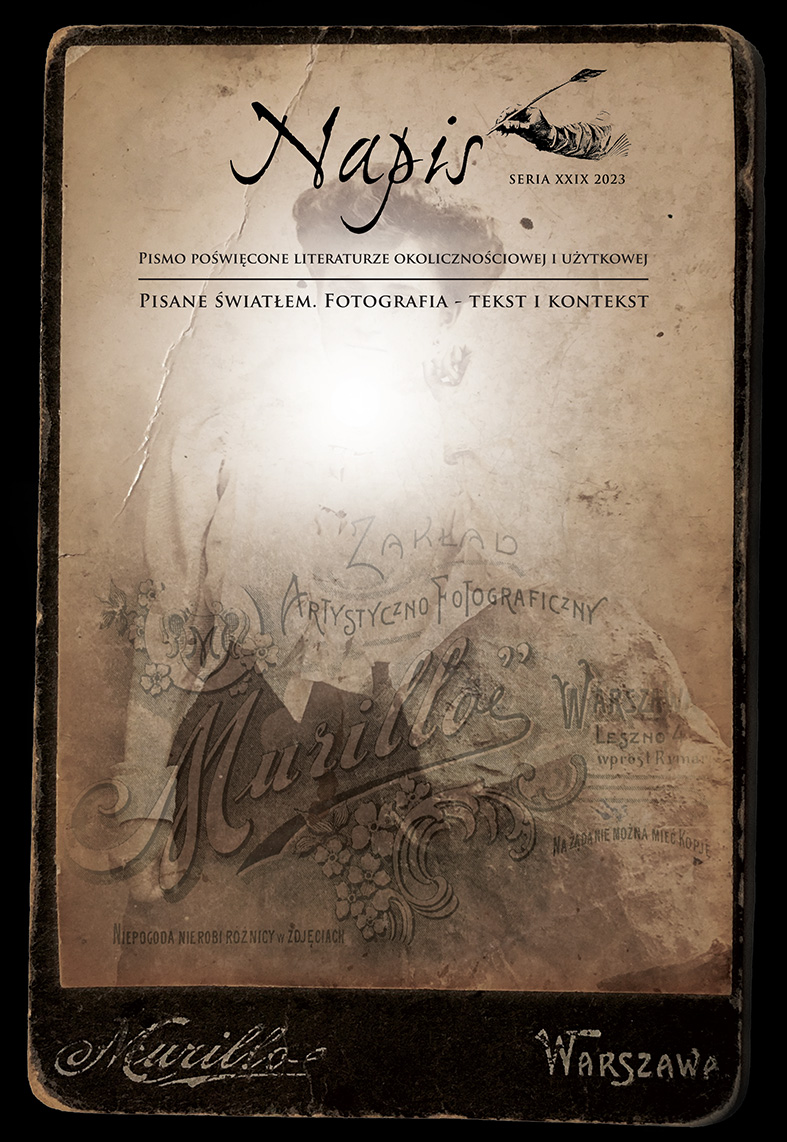
Publikacja dofinansowana ze środków budżetu państwa w ramach programu realizowanego przez Ministra Nauki i Szkolnictwa Wyższego pod nazwą „Rozwój Czasopism Naukowych” (nr umowy RCN/SP/0448/2021/1) zadania „Dofinansowanie rocznika naukowego „Napis. Pismo poświęcone literaturze okolicznościowej i użytkowej” w latach 2022-2024 na opublikowanie w sieci 2 numerów: numeru 29 „Pisane światłem. Fotografia – tekst i kontekst” (2023) oraz numeru specjalnego „Inscription. An Anthology 2” (2024), dofinansowanie projektu: 39 340 zł, całkowita wartość projektu: 47 740 zł.
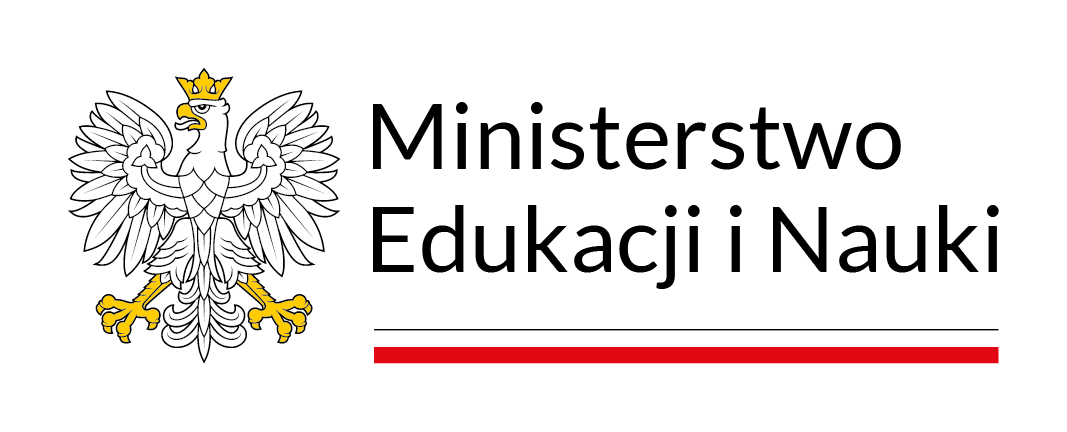
Wstęp: Fotografia: świet(l)ny portret nowoczesności (Marek Pąkciński, Agnieszka Bąbel)
Marek PĄKCIŃSKI
Rekonesans, oswojenie, inkorporacja – astronomiczna narracja popularnonaukowa przełomu XIX i XX wieku a ludzka świadomość poznająca Kosmos i odzwierciedlenie jej pozycji w fotografii
Artykuł (PDF) Show abstract Hide abstract
The article aims at tracing the role of photography in the popular scientific narrative on the Cosmos in selected examples from the second half of the nineteenth century and the first half of the twentieth century. The following authors have been selected to represent this kind of literature: Camille Flammarion and Sir James Jeans. Particular consideration is given (from the perspective of photography as scientific proof ) to the question of the ontological status of the objects of astronomy and physics research (stars, galaxies, planets, elementary particles, etc.). This status has, with the emergence of the theory of relativity and quantum mechanics in the first quarter of the twentieth century, undergone a significant change due to the need to include the awareness of the researcher into physical processes. The article recalls the outlooks of prominent physicists and science theoreticians (such as Sir Arthur Eddington, Bertrand Russell, Wolfgang Pauli and other representatives of the so-called panpsychism), who argued for the granting of a distinctively understood awareness not only to the subject (the researcher), but also to the object of study. Against this backdrop, the author endeavours to portray the ambivalent role of the photography of space objects, which, on the one hand, strengthens their autonomy in the process of the humans’ experience of them, but which, on the other hand, would be written into the expansionist narrative, suggesting the possibility of a neo-colonial exploitation of the riches of Space. The conclusion presents an allegorical interpretation of a short story Inwazja [Invasion] by Stanisław Lem, which, according to the author, is excellent at summarising the issue of the boundaries of human knowledge, experienced when confronting unknowable phenomena, in a narrow ‘Galileo-Cartesian’ epistemology.
Anna ZIĘBA, Daniel DZIENISIEWICZ
Urlop w PRL-u: multimodalna analiza dyskursu polskich widokówek z okresu 1945–1989
Artykuł (PDF) Show abstract Hide abstract
The article aims to present the results of a verbal and visual analysis of postcards sent in the Polish People’s Republic in the years 1945–1989. The study involved several hundred postcards sent from various locations at home and abroad. Using multimodal methodology of critical analysis of discourse, a study of the content of the postcards was carried out, pointing to the functions of text and image in the communications made using this medium. This work proves the occurrence of numerous links between the visual and textual layers of postcards. The discussion presented also leads to the conclusion that, alongside their primary phatic and informative function, postcards sent from travels also promoted the universally approved forms of leisure, encouraged visiting specific sites, strengthened national pride, as well as displayed the achievements of the Polish People’s Republic, presenting it as a modern and continually developing country.
Ewa SZKUDLAREK
Portrety fotograficzne w filmie polskim: pamiątka, ślad, rekwizyt
Artykuł (PDF) Show abstract Hide abstract
One of the more interesting phenomena in Polish cinematography is the use of the ‘photograph in film’ effect. Such a device enables the doubling of scenes and exhibiting of various photographic themes. A picture within a picture is an intermingling of moving and static image. Such constructions have an influence on various ways of storytelling, changes of timelines and spaces, as well as unexpected twists in a work of film. The selected photographic portraits in film, of Teresa Kociełło and Bogumił Niechcic (Noce i dnie [Nights and Days]), Władysław Niwiński (Polskie drogi [Polish Paths]), Barbara Lawinówna and Łukasz Zbożny (Dom [Home]), are connected by the tradition of family photography, black and white aesthetic, as well as by their links to socio-historical events (the outbreak of World War I, World War II, post-war effects of the Warsaw Uprising). The diverse interpretations of the theme of photography, however, set various perspectives in motion: a psychological one (Sigmund Freud),), anthropological one (Hans Belting), and, most importantly, those relating to the theory and aesthetics of photography (Roland Barthes, François Soulages, Marianna Michałowska). Photographic portraits in film also refer to different cultural, historical and social contexts (photography as memento, photography as trace, photography as prop), as well as presenting a complex mechanism of how the images of human memory function (remembering – reconstructing, fading – erasing).
Beata GARLEJ
Laury Makabresku „skradanie się” do wnętrza
Artykuł (PDF) Show abstract Hide abstract
The article is rooted in personal experience: the perception of photographic works by Laura Makabresku (Kamila Kansy) presented at the Inside Chamber exhibition in the Galeria Współczesnej Sztuki Sakralnej [Contemporary Sacral Art Gallery] at the Benedictine Abbey Musem in Tyniec. Attached to the works were quotes from Jerzy Zawieyski, Bohuslav Reynek, André Frossard and Rainer Maria Rilke. The dialogue between the photograph and the word constructed in this way revealed to the viewer the process of reaching the depths of the soul, and illustrated the change of its state. The article analyses three levels of a semantic ‘deepening’ of this dialogue, based on symbol and metaphor (of a path), which also refers one to the communicative dimension of a mystical experience. These musings are preceded by a theoretical section, which explains why the thought of philosopher Vilém Flusser is the methodological basis for the analysis of the three levels of dialogue of words with photography as presented by Laura Makabresku.
Marcin PLISZKA
„Zagapianie się” – na styku literatury i fotografii. „Dzień na ziemi” Michała Pawła Markowskiego
Artykuł (PDF) Show abstract Hide abstract
The article is dedicated to the discussion of Dzień na ziemi [A Day on Earth] by Michał Paweł Markowski, a book consisting, according to the author, of closely related parts: a fragment of novel prose, an essay on travel, and a collection of photographs. The spirit of the work is therefore one of an experimental lyrical-visual whole, with non-apparent rules on how it should be read. At the same time, it fits into the long tradition of iconotextual syncretism, though simultaneously, the presence of photographs determines its character. The often-problematised point of a photographic image, situating a photograph in the, impossible to reconcile, opposition of document and curated work of art, is further complicated in the work by Markowski due to the decision made by the author, who labelled all elements of his piece as ‘prose’, while accentuating their narrative aspect at the same time. Although photography is not the medium of epic, its textual contextualisations release narrative mechanisms, placing the task of rendering the nonuniform textual-visual material cohesive onto the reader.
The author of the study aims at analysing the way in which photography functions in the artistic whole created by Markowski. Photographs are present in the work in many ways: on a material level as an image embedded in the text, on a textual level as a story of the author of the picture, on a meta-level as an object of reflection, but also in an autonomous aspect, as a photography cycle, as well as commentary on the text and an element of the book’s visual design. The article analyses the mutual relations between word and image, interpretative procedures leading in different directions, as well as photographic-textual addenda and dialogue.
Joanna HAŁACZKIEWICZ
Melchior Wańkowicz i fotografia – uwagi edytorskie
Artykuł (PDF) Show abstract Hide abstract
The article is devoted to the visual layer of reportage by Melchior Wańkowicz, with a specific focus on works such as: Na tropach Smętka [Tracing Smętek] (1936), Sztafeta. Książka o polskim pochodzie gospodarczym [Relay. A Book on Polish Economic Advance] (1939) and Bitwa o Monte Cassino [The Battle of Monte Cassino] (1945–1947), his three most abundantly illustrated books, which, according to some, deserve to be regarded as photojournalism. Their author declared himself a proponent of the synthesis of text and image. He claimed that photography is a vector of the truth about the events described, that it makes text more attractive and credible, and that it visualises and synthesises that, which even the most skilled writer would have to present using a multitude of sentences. The article discusses editions published within the lifetime of the author, the appearance of which he had an influence over, as well as versions which came to be after 1989, the majority of which being testament to the lack of understanding of the author’s intentions. The article’s positioning of the statements by the author with fragments of the works published by him, the historical-cultural context, and opinions of readers proves the existence of close ties between text and image in the aforementioned reportage pieces. This, in turn, inspires one to reflect on what an exemplary edition of the illustrated works by Wańkowicz should look like today
Wiktor GARDOCKI
Cenzurowanie tekstów literackich dotyczących drugiej wojny światowej, okupacji i Zagłady. Kontrola słowa w latach 1966–1970
Artykuł (PDF) Show abstract Hide abstract
The stopping of a literary text, forcing the author to change the ending, or denying approval for a reprint are just several of many forms of repression used against writers in the period around the March events. World War II as a political (from the perspective of the censors) topic, was always treated as a priority by Główny Urząd Kontroli Prasy, Publikacji i Widowisk [Main Office for the Control of Presentations and Public Performances]. The actions of the Office had already intensified in the second half of the 1960s due to the tense situation in the country: the anti-Semitic campaign, removal of the play Dziady from performance programmes, the student protests. By censoring literary texts devoted to the Holocaust, armed conflict, or repatriations, attempts were made to shape the historical memory, as well as to build a positive image of the Polish People’s Republic. As presented by the analysis of archival material, these actions were used consistently over many years. Among the authors of halted or censored texts in 1966-1970, one can find Wincenty Burek, Kazimierz Brandys, Henryk Grynberg, Józef Hen, Jan Kurczab, or Jerzy Wilmański.
The article is divided into three principal parts. The first part discusses the archival legacy of Główny Urząd Kontroli Prasy, Publikacji i Widowisk (GUKPPiW) related to the topic of war and occupation. The second part explores strategies of control aimed at literary texts set between 1939 and 1945. The third part presents examples of censored texts. The aim of the article is to depict the contemporary mechanism of censoring of literary texts, whose time setting spans the years of World War II. The article also attempts to establish the extent to which those texts were distorted, and what the consequences of that were. It is also worth to highlight the existence of numerous archival artefacts relating to the years 1939-1945, and to point out the research perspectives associated with those.
Klara DESZCZYŃSKA
„Lenin” Ferdynanda Antoniego Ossendowskiego na tle wybranych literackich portretów wodza
Artykuł (PDF) Show abstract Hide abstract
The article is dedicated to portraying a literary-psychological aspect of creating the eponymous character of the novel by Ferdynand Antoni Ossendowski, Lenin (1930), that is, the famous Soviet leader, Vladimir Ilyich Ulyanov. The novel’s creation of the character described by Ossendowski was confronted with its incarnation in other twentieth-century literary works by the following authors: Curzio Malaparte ([Legend of Lenin] 1930), Aleksandr Solzhenitsyn (Lenin in Zürich 1975) and Mikhail Zoshchenko ([Stories About Lenin] 1940), as well as biographical works by Diane Ducret ([Dictators’ Women] 2011) and Dmitri Volkogonov ([Lenin. A Prophet of Heaven, An Apostle of Hell] 1997). The analysis includes references to contemporary psychological theories. In the work of Ossendowski, Lenin is a character consciously created as a complex personality, full of internal conflicts, captive to his Communist ideology obsession.
Liudmyla HARMASH
Reflections of War Experience in Ukrainian Songs
Artykuł (PDF) Pokaż abstrakt Ukryj abstrakt
Przedmiotem analizy w artykule jest piosenka jako najpopularniejszy gatunek literacki i muzyczny w latach wojny. Piosenki są dzielone według czasu powstania, patosu i tematów. Po 24 lutego 2022 roku piosenka stała się gatunkiem popularnym, co można tłumaczyć takimi cechami gatunku, jak masowy charakter, łatwość rozprzestrzenienia, siła oddziaływania, potencjał motywacyjny i oparcie na tradycjach ludowych. Analiza materiału tekstowego wykazała, że bohaterem lirycznym pieśni jest najczęściej obrońca ojczyzny, piosenki wyrażają bardzo zróżnicowane emocje, ale przeważa w nich heroiczny patos. Główną cechę większości piosenek stanowi okolicznościowość, co tłumaczy się potrzebą szybkiego reagowania na bieżące wydarzenia i wpływa na ich poziom artystyczny, a niekiedy skłania ich autorów do używania obscenicznego języka. Piosenki, które łączą wysoki poziom literacki i muzyczny tekstu z (na ogół) profesjonalnym wykonaniem, uzyskują największą liczbę wyświetleń w internecie.
Pisane światłem. Fotografia – tekst i kontekst. Prace studentów Akademii Sztuk Pięknych w Warszawie
Komentarze autorów do fotografii
Izabela MACIUSOWICZ
Krótka historia „rysowania światłem”. Ewolucja roli fotografii i jej pozycja wobec nowych technologii (zamiast posłowia)
Artykuł (PDF) Show abstract Hide abstract
The term photography means both the technological process of the formation of photographic image in the traditional or digital way, as well as its end product, that is, a photograph in the form of a print on light-sensitive paper or a digital file. The aim of the paper is to depict photography as a technique dependent on the development of science, but, at the same time, affecting the development of many areas of life and research. The article presents the most significant stages in the history of photography. It does not merely focus on listing the most prominent names, currents and works. Most importantly, it portrays the speed with which photography improved, together with new experiences and inventions of apparatus and technological processes, continuous striving for excellence in the image obtained, as well as fundamental changes to the function of photographic image once the press, Internet and social media came to be, allowing one to share pictures taken all over the world in a split second. The perfection of the photographic image and its vast spread led to the use of pictures uploaded to the Internet in AI algorithms.
Katarzyna NADANA-SOKOŁOWSKA, Flâneurka schodzi do piekła – „Kroniki wojenne 1939-1944” Aurelii Wyleżyńskiej (Aurelia Wyleżyńska, Kroniki wojenne, t. 1: 1939–1942, t. 2: 1943–1944, oprac. Grażyna Pawlak, Marcin Urynowicz, Państwowy Instytut Wydawniczy, Warszawa 2022)
Noty o autorach artykułów

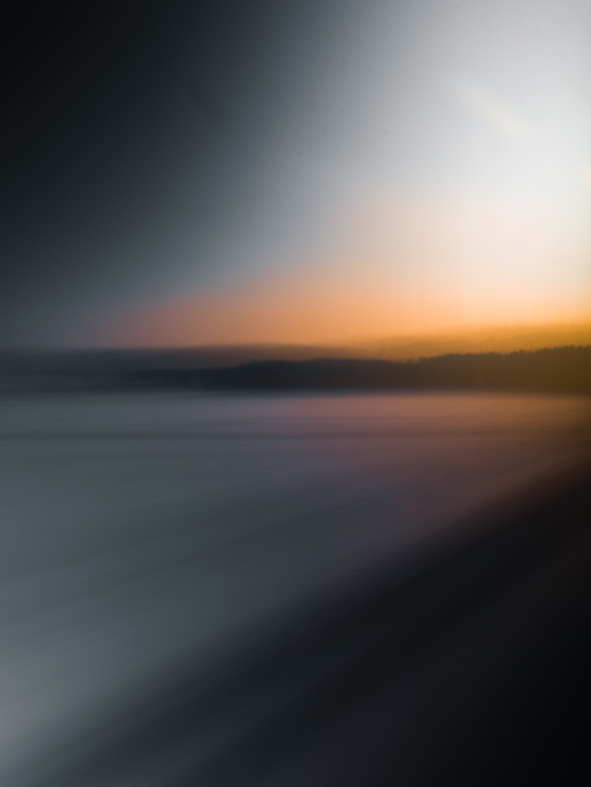
Maksymilian Gwizdała
Fotografia została wykonana podczas jednej z moich weekendowych podróży po Polsce.
Jadąc pociągiem przez dopiero co ośnieżony, malowniczy krajobraz, wyciągnąłem aparat z plecaka i zacząłem robić zdjęcia, skupiając się na świetle. Jedynym jego źródłem było słońce.
Fotografie powstawały w ruchu z długim naświetlaniem, co nadało im efekt namalowanego obrazu.
Wyjątkowość tej fotografii polega na tym, że praktycznie niemożliwe jest odtworzenie wszystkich parametrów, występujących podczas robienia zdjęcia.
[Fotografia kolorowa: ośnieżona równina i ciemne pasmo lasu na horyzoncie.]
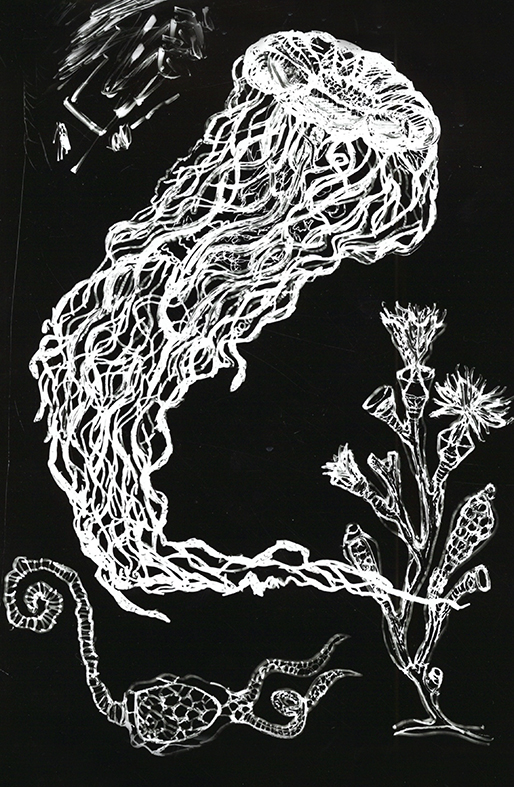
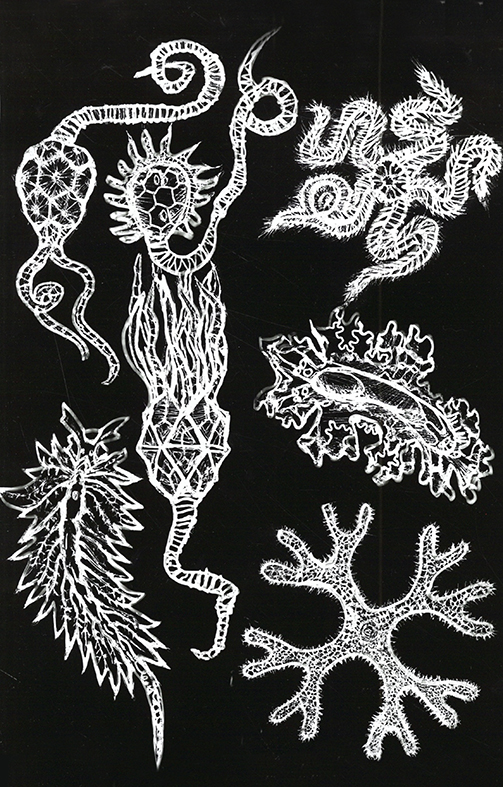
Alesia Maisei
Prace są tworzone poprzez bezpośrednie naświetlanie światłoczułego materiału (tutaj: papieru fotograficznego), bez użycia aparatu. Układałam na papierze kompozycje, które następnie naświetlałam. Po wywołaniu powstaje negatywowy obraz, który nazywa się fotogramem. Ich tworzenie jest procesem artystycznym, związanym z eksperymentowaniem z kompozycją, światłem i formą.
Odbitki są poświęcone mikroorganizmom fototroficznym – roślinom, bakteriom i protistom, które odżywiają się za pomocą energii świetlnej.
Fototrofia odgrywa kluczową rolę w łańcuchach pokarmowych, umożliwiając organizmom fotosyntetycznym produkcję pożywienia.
[Dwie kompozycje z białych organicznych kształtów na czarnym tle.]
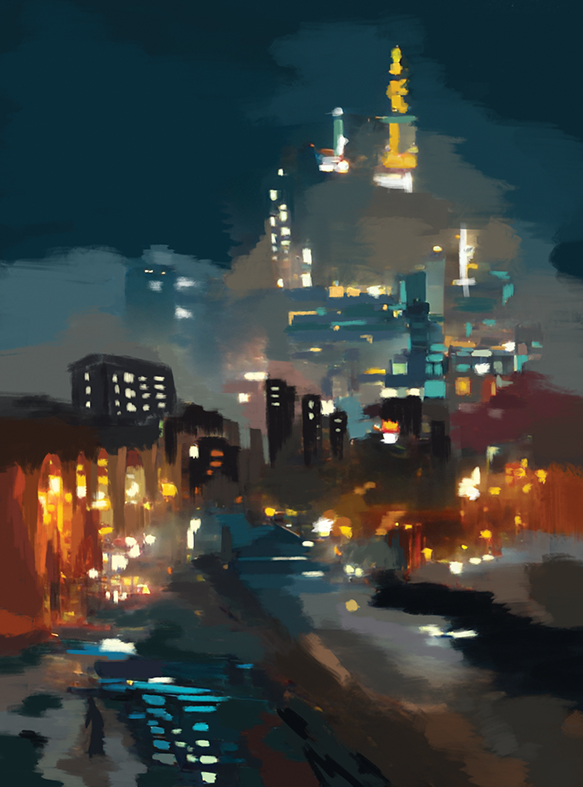
Amelia Rejer
Bez komentarza.
[Fotografia kolorowa: pejzaż wielkiego miasta nocą.]
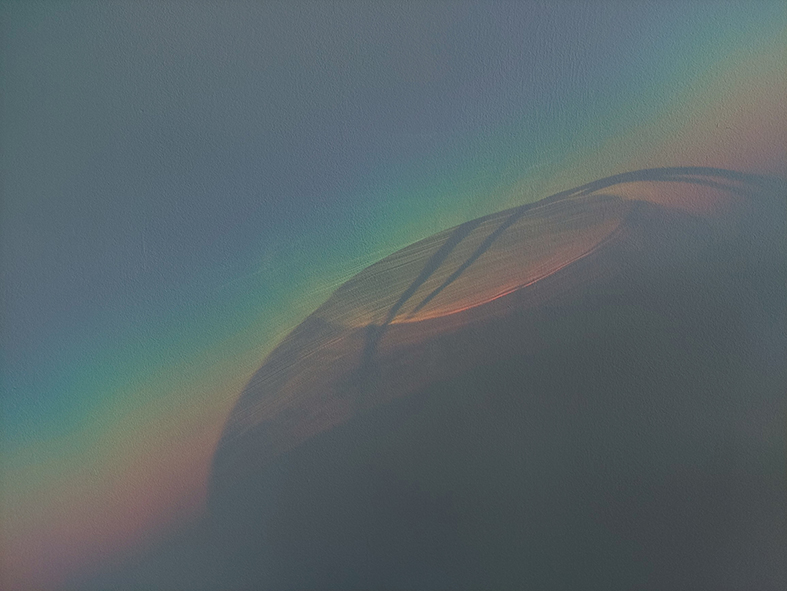
Urszula Chocian
Na zdjęciu jest widoczne światło tworzące tęczę, załamane przez szkło akwarium, rzucone na białą ścianę. Tekstura ściany imituje wygląd podobrazia, a smugi światła przypominają pociągnięcia pędzlem. Powstałe delikatne cienie wyglądają jak runy czy zapomniany alfabet lub wzór, który mógł być stosowany przez pradawne ludy. W dwóch pasach cienia można doszukać się własnej interpretacji, tylko jedno jest pewne – jak szkło jest źródłem załamania światła, tak widoczne pasy „załamują” jego drogę dotarcia do ściany i burzą kompozycję świetlną, która mogła powstać.
[Fotografia kolorowa: ukośne pasmo tęczy między cieniami.]


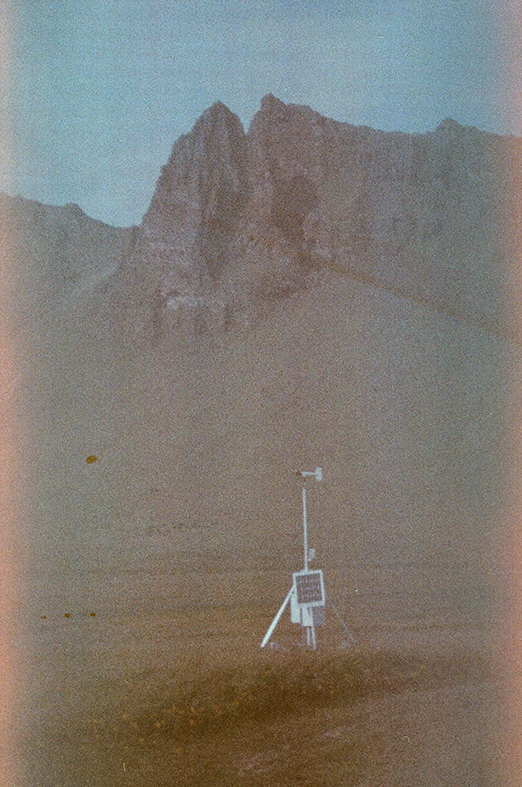
Mikołaj Karwan-Jastrzębski
Tym, co fascynuje mnie w fotografii analogowej, jest eksperymentowanie z kliszą. Fotografując na starych, często kilkudziesięcioletnich filmach, uzyskuję efekty, które nabierają nowego znaczenia. Obraz zaskakuje. Kadr jak z fotografii sprzed wieku nosi w sobie inne światło. I ono właśnie, jako pełnoprawny element, samo zaczyna opowiadać historię inaczej, wrzuca ją w inny czas. To tak, jakby wyrwać z minionego świata kadr i wstawić go we współczesność. Zdjęcia wykonane zostały na kliszy Orwo Chrom UT21 z datą użytku do listopada 1991 roku. Film włożono do aparatu we wrześniu 2023 roku, ponad 30 lat po dacie przydatności sygnalizowanej przez producenta. Fotografie przedstawiają małą miejscowość Vík í Mýrdal, najbardziej wysunięty na południe punkt Islandii, którą zamieszkuje około 400 osób.
[Trzy fotografie kolorowe: człowiek prowadzący konia na polu; kościół na wzgórzu; skalisty grzbiet na tle nieba, na pierwszym planie stacja meteorologiczna.]
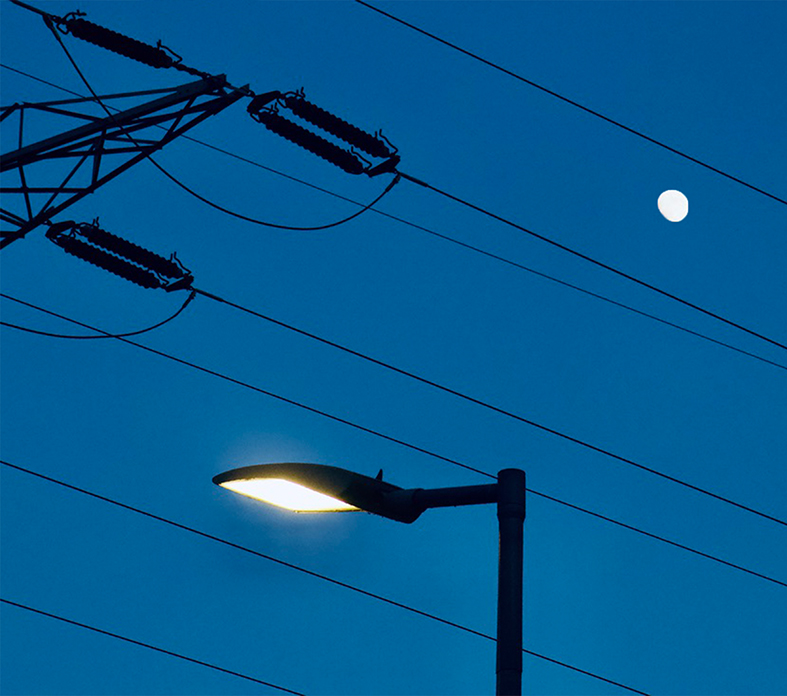
Jan Staroń
„Dosłownie rzecz biorąc, zdjęcie jest emanacją przedmiotu odniesienia. Od rzeczywistego ciała, które tu było, pobiegły promienie, które dotykają mnie – mnie, który tu jestem. […] Światło, chociaż niedotykalne, jest tutaj środowiskiem cielesnym, naskórkiem, który dzielę ze sfotografowanymi: z nim lub z nią.
Zdaje się, że po łacinie „fotografia” nazywałaby się: „imago lucis opera expressa”, to znaczy obraz wywołany, „wyjęty”, „wyrażony”, „wyciśnięty” (jak sok z cytryny) przez działanie światła.”
(R. Barthes, Światło obrazu, tłum. J. Trznadel, Warszawa 2008, s. 144).
[Fotografia kolorowa: lampa uliczna i księżyc na tle wieczornego nieba, przeciętego przewodami trakcji elektrycznej.]
